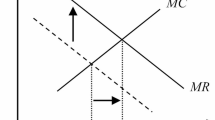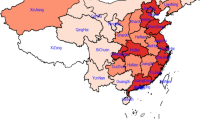Abstract
To reduce industrial carbon emissions, various industries have been seeking ways to reduce their own emissions. Implementing carbon trading system measures is one way to effectively control industrial carbon emissions. However, in different industrial sectors, carbon trading systems have different impact. The 14-year provincial panel data (2005–2019) were analyzed by using the propensity score matching and the difference-in-difference model to evaluate the role of the emission trading system (ETS) in reducing emissions from different industries. According to the study, ETS has reduced carbon emissions from the agricultural production sector by 1.6876%. Secondly, it also had a significant inhibitory effect on the manufacturing sector, about 24.0489. Mining, electricity production, wholesale and other industrial sectors are insignificant disincentives, and construction and transportation are insignificant facilitators. China’s ETS, therefore, mainly acts as an inhibitory force for different industries, which can effectively reduce their carbon emissions.



Similar content being viewed by others
References
Ali, M. U., Gong, Z. M., & Yao, C. (2021). Fossil energy consumption, economic development, inward FDI impact on CO(2) emissions in Pakistan: Testing EKC hypothesis through ARDL model. International Journal of Finance & Economics, 26(3), 3210–3221.
Bano, S., Zhao, Y. H., & Liu, Y. (2018). Identifying the impacts of human capital on carbon emissions in Pakistan. Journal of Cleaner Production, 183, 1082–1092.
Deng, M. Z., & Zhang, W. X. (2019). Recognition and analysis of potential risks in China’s carbon emission trading markets. Advances in Climate Change Research, 10(1), 30–46.
Fan, D. L., Huang, Y. X., Yong-Jian, P. U., et al. (2017). CO2 emission from fossil energy consumption in chongqing and prediction of its peak. Journal of Southwest University (natural Science Edition), 39, 180–185.
Gao, Y. N., Li, M., et al. (2020). Evaluation of effectiveness of China’s carbon emissions trading scheme in carbon mitigation. Energy Economics, 90, 104872.
Guo, H., & Liang, J. (2016). An optimal control model for reducing and trading of carbon emissions. Physica a: Statistical Mechanics and Its Applications, 446, 11–21.
Guo, J. H., Sun, L. Y., & Zhou, T. Q. (2021). Analysis of the evolutionary game of decisions to reduce carbon emissions by Duopoly manufacturers under carbon tax policy. Environmental Engineering and Management Journal, 20(4), 645–658.
Hu, Y. C., Ren, S. G., et al. (2020). Can carbon emission trading scheme achieve energy conservation and emission reduction? Evidence from the industrial sector in China. Energy Economics, 85, 104590.
Huang, Z. H., & Du, X. J. (2020). Toward green development? Impact of the carbon emissions trading system on local governments’ land supply in energy-intensive industries in China. Science of the Total Environment, 738, 139769.
Lawson, L. A. (2020). GHG emissions and fossil energy use as consequences of efforts of improving human well-being in Africa. Journal of Environmental Management, 273, 111136.
Li, G., Yang, J., Chen, D., & Hu, S. (2017). Impacts of the coming emission trading scheme on China’s. Coal-to-materials industry in 2020. Applied Energy, 195, 837–849.
Li, X. Y., & Tang, B. J. (2017). Incorporating the transport sector into carbon emission trading scheme: An overview and outlook. Natural Hazards, I(88), 683–698.
Liang, Y., Niu, D. X., & Fan, Y. Y. (2018). Decomposition analysis of carbon emissions from energy consumption in Beijing-Tianjin-Hebei, China: A weighted-combination model based on logarithmic mean divisia index and Shapley value. Sustainability, 10(7), 2535.
Lin, B., & Jia, Z. (2018). Impact of quota decline scheme of emission trading in China: A dynamic. Recursive CGE model. Energy, 149, 190–203.
Liu, X. N., Wang, B., & Zhang, N. (2018). Potential economic gains and emissions reduction on carbon emissions trading for China’s large-scale thermal power plants. Journal of Cleaner Production, 204, 247–257.
Pan, J. L., Chiu, C. Y., & Wang, Y. W. (2020). Sustainable production-inventory model in technical cooperation on investment to reduce carbon emissions. Process, 8(11), 1438.
Sun, Y. P. (2017). Annual report of China carbon emissions trading scheme. Social Science Academic Press (China), 1–13.
Tan, K., Zhou, Y., et al. (2021). The effectiveness and heterogeneity of carbon emissions trading scheme in China. Environmental Science and Pollution Research, 28(14), 17306–17318.
Tang, K., Liu, Y. C., & Qiu, Y. (2021). Urban carbon emission intensity under emission trading system in a developing economy: Evidence from 273 Chinese cities. Environmental Science and Pollution Research, 28(5), 5168–5169.
Xu, H., Liu, B. Z., & Liu, B. (2022). Does the new energy demonstration cities construction reduce CO2 emission? Evidence from a quasi-natural experiment in China. Environmental Science and Pollution Research.
Ye, H., Ren, Q., & Pan, B. (2017). Low-carbon behavior approaches for reducing direct carbon emissions: Household energy use in a coastal city. Journal of Cleaner Production, 141, 128–136.
Yu, X., Shen, M. H., & Imwa, B. T. (2019). Does the low-carbon pilot initiative reduce carbon emissions? Evidence from the application of the synthetic control method in Guangdong Province. Sustainaility, 14(11), 3979.
Yu, X. Y., Dong, Z. J., & Huang, X. H. (2021). Integration of tradable green certificates trading and carbon emissions trading: How will Chinese power industry do? Journal of Cleaner Production, 279, 123485.
Zeng, B. X., Xie, J., & Zhu, L. (2019). The impacts of emission trading scheme on China’s thermal power industry: A pre-evaluation from the micro level. Energy & Environment, 6(31), 1007–1030.
Zhang, J. K., & Zhang, Y. (2020). Could the ETS reduce tourism-related CO(2) emissions and carbon intensity? A quasi-natural experiment. Asia Pacific Journal of Tourism Research, 25(9), 1029–1041.
Zhang, Y. L., Zhang, Q. Y., & Pan, B. B. (2019). Impact of affluence and fossil energy on China carbon emissions using STIRPAT model. Environmental Science and Pollution Research, 26(18), 18814–18824.
Zheng, Z., Xiao, R., Shi, H., Li, G., & Zhou, X. (2015). Statistical regularities of carbon emission trading market: Evidence from European Union allowances. Physica a: Statistical Mechanics and Its Applications, 426, 9–15.
Funding
Funding was provided by National Natural Science Foundation of China (Grant Nos. 72171123, 72171149), Shanghai Philosophy and Social Science Foundation (Grant No. 2020BGL010), National Social Science Major Foundation of China (Grant No. 21ZDA105).
Author information
Authors and Affiliations
Corresponding author
Additional information
Publisher's Note
Springer Nature remains neutral with regard to jurisdictional claims in published maps and institutional affiliations.
Electronic supplementary material
Below is the link to the electronic supplementary material.
Appendix: Parallel trend test
Appendix: Parallel trend test
First | Mining | Manufacturing | Electricity | |
|---|---|---|---|---|
Pre_4 | 1.65 (0.164) | 2.36 (0.400) | − 7.62 (0.537) | − 2.75 (0.842) |
Pre_3 | 0.62 (0.527) | − 2.36 (0.312) | 1.66 (0.871) | 1.06 (0.926) |
Pre_2 | 0.31 (0.732) | 1.16 (0.595) | − 0.48 (0.960) | 7.72 (0.469) |
Current | − 1.47 (0.111) | − 2.68 (0.219) | − 24.84 (0.010) | − 0.19 (0.986) |
Post_1 | − 2.16 (0.029) | − 2.50 (0.282) | − 22.56 (0.028) | 5.97 (0.600) |
Post_2 | − 2.78 (0.011) | − 2.02 (0.434) | − 20.18 (0.077) | 5.34 (0.672) |
Post_3 | − 3.92 (0.002) | − 0.75 (0.797) | − 24.32 (0.058) | 6.40 (0.653) |
Post_4 | − 4.26 (0.003) | − 2.77 (0.411) | − 27.30 (0.066) | 9.51 (0.563) |
Constant | − 8.03 (0.036) | 27.83 (0.000) | 72.81 (0.067) | − 41.76 (0.345) |
Control | Yes | Yes | Yes | Yes |
Province FE | Yes | Yes | Yes | Yes |
Year FE | Yes | Yes | Yes | Yes |
Province FE*year trend | Yes | Yes | Yes | Yes |
R-square | 0.8972 | 0.9707 | 0.9876 | 0.9935 |
Construction | Transport | Wholesale | Others | |
|---|---|---|---|---|
Pre_4 | − 0.36 (0.494) | − 0.13 (0.963) | 0.37 (0.861) | 0.46 (0.783) |
Pre_3 | − 0.36 (0.409) | − 0.09 (0.968) | 0.95 (0.588) | 0.20 (0.886) |
Pre_2 | − 0.05 (0.912) | 0.20 (0.926) | 0.51 (0.757) | 0.30 (0.814) |
Current | − 0.004 (0.992) | 0.70 (0.744) | 0.83 (0.616) | − 0.55 (0.669) |
Post_1 | 0.08 (0.857) | 0.53 (0.817) | − 0.27 (0.876) | − 0.20 (0.883) |
Post_2 | 0.01 (0.988) | 2.16 (0.397) | − 0.94 (0.630) | − 0.59 (0.700) |
Post_3 | − 0.87 (0.112) | 5.17 (0.072) | − 1.26 (0.568) | − 0.20 (0.909) |
Post_4 | − 0.93 (0.139) | 5.61 (0.091) | − 0.94 (0.713) | 0.38 (0.847) |
Constant | − 4.37 (0.010) | 2.45 (0.783) | − 13.67(0.046) | − 7.87 (0.141) |
Control | Yes | Yes | Yes | Yes |
Province FE | Yes | Yes | Yes | Yes |
Year FE | Yes | Yes | Yes | Yes |
Province FE*year trend | Yes | Yes | Yes | Yes |
R-square | 0.9357 | 0.9771 | 0.8710 | 0.8733 |
Rights and permissions
Springer Nature or its licensor holds exclusive rights to this article under a publishing agreement with the author(s) or other rightsholder(s); author self-archiving of the accepted manuscript version of this article is solely governed by the terms of such publishing agreement and applicable law.
About this article
Cite this article
Qu, S., Ma, H. The impact of carbon policy on carbon emissions in various industrial sectors based on a hybrid approach. Environ Dev Sustain 25, 14437–14451 (2023). https://doi.org/10.1007/s10668-022-02673-0
Received:
Accepted:
Published:
Issue Date:
DOI: https://doi.org/10.1007/s10668-022-02673-0




